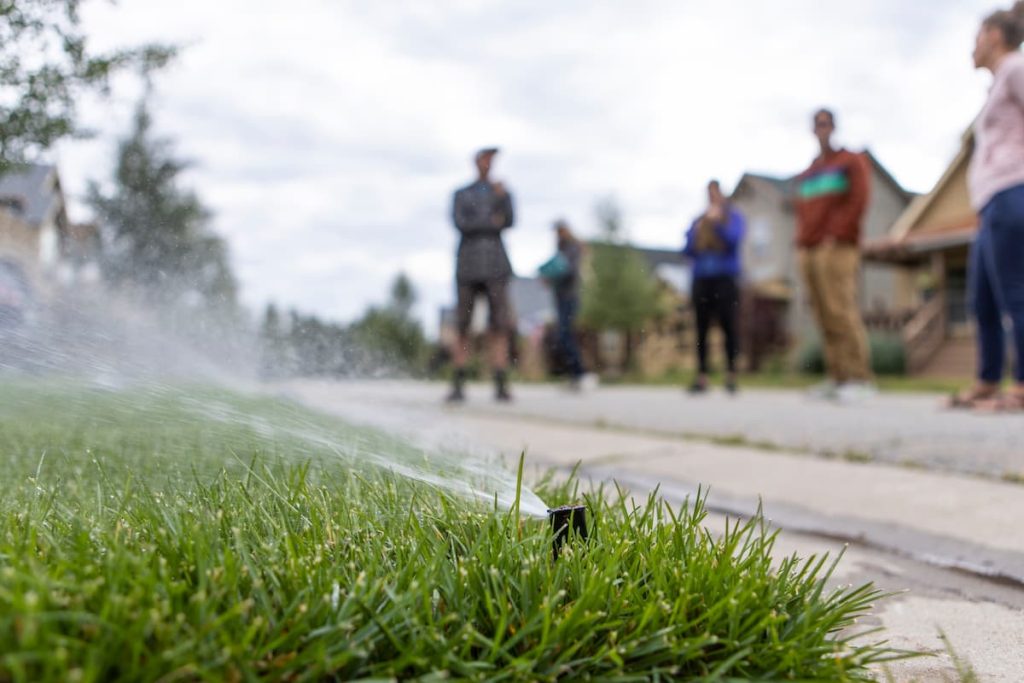
Dear Eartha,
I’m struggling to keep my grass growing, and I’m considering artificial turf for my kids and dog. Is this a good option?
It seems like we’ve all seen artificial turf pop up on sports fields and neighbors’ lawns and thought: gee that seems like a great way to save some water and time spent mowing, and still enjoy beautiful, green grass! Especially as we hear about the shrinking Colorado River and notice that it’s more expensive to keep our lawns green with the cost of water going up; artificial turf can seem like a great solution to our environmental woes.
Unfortunately, artificial turf has been found to have some serious drawbacks. Research has shown that it can contain harmful chemicals that can get into our bodies, soil, and waterways, that it can hinder the amount of groundwater returning to our aquifers. Sometimes, for maintenance and cooling purposes, it can still require watering! There are also concerns about waste, heat, and sanitation. Let’s dive into those concerns and explore what alternatives we have.
Harmful chemicals
Since artificial turf is made of plastic, all its components contain a variety of chemicals. And unfortunately, some of those components have been found to contain 179 toxic chemicals. Now imagine your children playing on an artificial turf sports field, or in your backyard. During play, your children and pets will be exposed to these chemicals as they break down and leach out into the air, soil and water. The human health impacts of these chemicals are still being studied and are currently inconclusive, but some studies have found an increased cancer risk. In smaller vertebrate animals, like chickens, some studies have shown that exposure to these chemicals can cause severe birth defects.
Water impacts
We all want to see healthy flowing rivers and have access to clean, abundant water supplies. Artificial turf may hurt those desires as the plastic sheeting used underneath the artificial turf can stop groundwater recharge, and the chemicals mentioned above in artificial turf can make their way into our waterways. PFAS are some of the chemicals in artificial turf that can have serious human and animal health impacts. PFAS are known as “forever chemicals” and are hard to clean out of the water once they are there.
As we face increasingly hotter summers, artificial turf can also soak up the heat and make it dangerous for our kids and pets to walk or play on. Artificial turf can measure up to 80 degrees hotter than the surrounding air temperature on a hot day! One way to cool it down, temporarily, is to soak it with a lot of water. Not so good for water savings! Natural landscaping, however, can disperse the heat of the sun and keep your yard, and your family cool.

Waste worries
For your dog, artificial turf is not the cleanest option as it requires rinsing and at times even scrubbing with cleaners and chemicals to get it back to a hygienic state. In addition to pet waste struggles, artificial turf can also contribute to waste at the end of its life. Artificial turf can be almost impossible to recycle and requires replacement every 8 to 10 years. There are piles of used artificial turf building up all over the world with no recycling or disposal solution.
What are good alternatives?
There are a variety of native and high-country climate plants that will thrive in your yard, save water and provide a beautiful space for you, your children, and your dog to enjoy. There are even species of low water use turf grass that are dog safe and grow well in our climate with less upkeep.
Check out Colorado State University Extension for tips and planting ideas. Not ready to tackle a project on your own? High Country Conservation Center maintains a list of local landscapers certified in efficient irrigation. Those landscapers are also an excellent resource for designing, installing and maintaining native plants that provide pollinator habitat, reduce irrigation and mowing costs and contribute to a healthier environment.
Ask Eartha Steward is written by the staff and occasional guest contributors for the High Country Conservation Center, a nonprofit dedicated to waste reduction and resource conservation. Submit questions to Eartha at info@highcountryconservation.org. Guest columnist Chelsea Benjamin works to protect healthy rivers in the West as a Water Policy Fellow at Western Resource Advocates. The information she shared above can be found in her report on the benefits and drawbacks of artificial turf at westernresourceadvocates.org.
